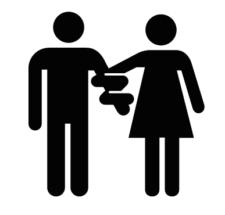4.2.1: Subject Object and Possesive Pronouns and Possesive Adjectives
- Page ID
- 257445
\( \newcommand{\vecs}[1]{\overset { \scriptstyle \rightharpoonup} {\mathbf{#1}} } \)
\( \newcommand{\vecd}[1]{\overset{-\!-\!\rightharpoonup}{\vphantom{a}\smash {#1}}} \)
\( \newcommand{\id}{\mathrm{id}}\) \( \newcommand{\Span}{\mathrm{span}}\)
( \newcommand{\kernel}{\mathrm{null}\,}\) \( \newcommand{\range}{\mathrm{range}\,}\)
\( \newcommand{\RealPart}{\mathrm{Re}}\) \( \newcommand{\ImaginaryPart}{\mathrm{Im}}\)
\( \newcommand{\Argument}{\mathrm{Arg}}\) \( \newcommand{\norm}[1]{\| #1 \|}\)
\( \newcommand{\inner}[2]{\langle #1, #2 \rangle}\)
\( \newcommand{\Span}{\mathrm{span}}\)
\( \newcommand{\id}{\mathrm{id}}\)
\( \newcommand{\Span}{\mathrm{span}}\)
\( \newcommand{\kernel}{\mathrm{null}\,}\)
\( \newcommand{\range}{\mathrm{range}\,}\)
\( \newcommand{\RealPart}{\mathrm{Re}}\)
\( \newcommand{\ImaginaryPart}{\mathrm{Im}}\)
\( \newcommand{\Argument}{\mathrm{Arg}}\)
\( \newcommand{\norm}[1]{\| #1 \|}\)
\( \newcommand{\inner}[2]{\langle #1, #2 \rangle}\)
\( \newcommand{\Span}{\mathrm{span}}\) \( \newcommand{\AA}{\unicode[.8,0]{x212B}}\)
\( \newcommand{\vectorA}[1]{\vec{#1}} % arrow\)
\( \newcommand{\vectorAt}[1]{\vec{\text{#1}}} % arrow\)
\( \newcommand{\vectorB}[1]{\overset { \scriptstyle \rightharpoonup} {\mathbf{#1}} } \)
\( \newcommand{\vectorC}[1]{\textbf{#1}} \)
\( \newcommand{\vectorD}[1]{\overrightarrow{#1}} \)
\( \newcommand{\vectorDt}[1]{\overrightarrow{\text{#1}}} \)
\( \newcommand{\vectE}[1]{\overset{-\!-\!\rightharpoonup}{\vphantom{a}\smash{\mathbf {#1}}}} \)
\( \newcommand{\vecs}[1]{\overset { \scriptstyle \rightharpoonup} {\mathbf{#1}} } \)
\( \newcommand{\vecd}[1]{\overset{-\!-\!\rightharpoonup}{\vphantom{a}\smash {#1}}} \)
\(\newcommand{\avec}{\mathbf a}\) \(\newcommand{\bvec}{\mathbf b}\) \(\newcommand{\cvec}{\mathbf c}\) \(\newcommand{\dvec}{\mathbf d}\) \(\newcommand{\dtil}{\widetilde{\mathbf d}}\) \(\newcommand{\evec}{\mathbf e}\) \(\newcommand{\fvec}{\mathbf f}\) \(\newcommand{\nvec}{\mathbf n}\) \(\newcommand{\pvec}{\mathbf p}\) \(\newcommand{\qvec}{\mathbf q}\) \(\newcommand{\svec}{\mathbf s}\) \(\newcommand{\tvec}{\mathbf t}\) \(\newcommand{\uvec}{\mathbf u}\) \(\newcommand{\vvec}{\mathbf v}\) \(\newcommand{\wvec}{\mathbf w}\) \(\newcommand{\xvec}{\mathbf x}\) \(\newcommand{\yvec}{\mathbf y}\) \(\newcommand{\zvec}{\mathbf z}\) \(\newcommand{\rvec}{\mathbf r}\) \(\newcommand{\mvec}{\mathbf m}\) \(\newcommand{\zerovec}{\mathbf 0}\) \(\newcommand{\onevec}{\mathbf 1}\) \(\newcommand{\real}{\mathbb R}\) \(\newcommand{\twovec}[2]{\left[\begin{array}{r}#1 \\ #2 \end{array}\right]}\) \(\newcommand{\ctwovec}[2]{\left[\begin{array}{c}#1 \\ #2 \end{array}\right]}\) \(\newcommand{\threevec}[3]{\left[\begin{array}{r}#1 \\ #2 \\ #3 \end{array}\right]}\) \(\newcommand{\cthreevec}[3]{\left[\begin{array}{c}#1 \\ #2 \\ #3 \end{array}\right]}\) \(\newcommand{\fourvec}[4]{\left[\begin{array}{r}#1 \\ #2 \\ #3 \\ #4 \end{array}\right]}\) \(\newcommand{\cfourvec}[4]{\left[\begin{array}{c}#1 \\ #2 \\ #3 \\ #4 \end{array}\right]}\) \(\newcommand{\fivevec}[5]{\left[\begin{array}{r}#1 \\ #2 \\ #3 \\ #4 \\ #5 \\ \end{array}\right]}\) \(\newcommand{\cfivevec}[5]{\left[\begin{array}{c}#1 \\ #2 \\ #3 \\ #4 \\ #5 \\ \end{array}\right]}\) \(\newcommand{\mattwo}[4]{\left[\begin{array}{rr}#1 \amp #2 \\ #3 \amp #4 \\ \end{array}\right]}\) \(\newcommand{\laspan}[1]{\text{Span}\{#1\}}\) \(\newcommand{\bcal}{\cal B}\) \(\newcommand{\ccal}{\cal C}\) \(\newcommand{\scal}{\cal S}\) \(\newcommand{\wcal}{\cal W}\) \(\newcommand{\ecal}{\cal E}\) \(\newcommand{\coords}[2]{\left\{#1\right\}_{#2}}\) \(\newcommand{\gray}[1]{\color{gray}{#1}}\) \(\newcommand{\lgray}[1]{\color{lightgray}{#1}}\) \(\newcommand{\rank}{\operatorname{rank}}\) \(\newcommand{\row}{\text{Row}}\) \(\newcommand{\col}{\text{Col}}\) \(\renewcommand{\row}{\text{Row}}\) \(\newcommand{\nul}{\text{Nul}}\) \(\newcommand{\var}{\text{Var}}\) \(\newcommand{\corr}{\text{corr}}\) \(\newcommand{\len}[1]{\left|#1\right|}\) \(\newcommand{\bbar}{\overline{\bvec}}\) \(\newcommand{\bhat}{\widehat{\bvec}}\) \(\newcommand{\bperp}{\bvec^\perp}\) \(\newcommand{\xhat}{\widehat{\xvec}}\) \(\newcommand{\vhat}{\widehat{\vvec}}\) \(\newcommand{\uhat}{\widehat{\uvec}}\) \(\newcommand{\what}{\widehat{\wvec}}\) \(\newcommand{\Sighat}{\widehat{\Sigma}}\) \(\newcommand{\lt}{<}\) \(\newcommand{\gt}{>}\) \(\newcommand{\amp}{&}\) \(\definecolor{fillinmathshade}{gray}{0.9}\)- Identify functions of pronouns
- Identify pronoun person and number
- Identify pronoun case (subjects, objects, possessives)
- Identify pronoun and antecedent clarity
- Identify pronoun and antecedent agreement

Figure \(\PageIndex{1}\)
Read and Observe
Anna decided at the beginning of Anna’s first semester of college that Anna would run for thirty minutes every day. Anna knew that Anna would be taking a literature class with a lot of reading, so instead of buying print copies of all the novels Anna’s teacher assigned, Anna bought the audiobooks. That way Anna could listen to the audiobooks as Anna ran.
Does this paragraph feel awkward to you? Let’s try it again using pronouns:
Anna decided at the beginning of her first semester of college that she would run for thirty minutes every day. She knew that she would be taking a literature class with a lot of reading, so instead of buying hard copies of all the novels her teacher assigned, Anna bought the audiobooks. That way she could listen to them as she ran.
This second paragraph is much more natural. Instead of repeating nouns multiple times, we were able to use pronouns. You’ve likely hear the phrase “a pronoun replaces a noun”; this is exactly what a pronoun does.
In this outcome, you’ll learn how pronouns work, how to use pronouns in different situations, and how to select the correct pronouns.
Function of Pronouns
A pronoun stands in the place of a noun. Because a pronoun is replacing a noun, its meaning is dependent on the noun that it is replacing. This noun is called the antecedent. Let’s look at the two sentences we just read again:
Because a pronoun is replacing a noun, its meaning is dependent on the noun that it is replacing. This noun is called an antecedent.
Whenever you use a pronoun, you must also include its antecedent. Without the antecedent, your readers (or listeners) won’t be able to figure out what the pronoun is referring to. Let’s look at a couple of examples:
- Mary likes it when people look to her for leadership.
- Billy went to a party for his friend. He gave him a present when he arrived.
- Kimberly is a gymnast. She has earned several medals in different competitions.
So, what are the antecedents and pronouns in these sentences?
- Mary is the antecedent for the pronoun her.
- His friend is the antecedent for the pronoun him.
- Billy is the antecedent for the pronoun he.
- Kimberly is the antecedent for the pronoun she.
Identify the antecedent in the following examples:
- The bus is twenty minutes late today, like it always is.
- I would never forget to give my wife a gift for our anniversary. She would be very disappointed!
- Answer
-
- The bus is the antecedent for the pronoun it.
- my wife is the antecedent for the pronoun she.
There are several types of pronouns, including personal, demonstrative, and indefinite pronouns. Let’s discuss each of these types.
Subject and Object Pronouns
English personal pronouns have two cases: subject and object (there are also possessive pronouns, which we’ll discuss next). Subject-case pronouns are used when the pronoun is doing the action. (I like to eat chips, but she does not). Object-case pronouns are used when something is being done to the pronoun (John likes me but not her). This video will further clarify the difference between subject- and object-case:
Select the response from the list that best completes the sentence.
- I don’t know if I should talk to (he / him). (He / Him) looks really angry today.
- Enrico and Brenna are coming over for dinner tomorrow night. (They / Them) will be here at 6:00.
- Melissa loves music. (She / Her) listens to it when I drive (she / her) to work.
- Answer
-
- I don’t know if I should talk to him. He looks really angry today.
- Enrico and Brenna are coming over for dinner tomorrow night. They will be here at 6:00.
- Melissa loves music. She listens to it when I drive her to work.
Some of the most common pronoun mistakes occur with the decision between “you and I” and “you and me.” People will often say things like “You and me should go out for drinks.” Or—thinking back on the rule that it should be “you and I”—they will say “Susan assigned the task to both you and I.” However, both of these sentences are wrong. Remember that every time you use a pronoun you need to make sure that you’re using the correct case.
Let’s take a look at the first sentence: “You and me should go out for drinks.” Both pronouns are the subject of the sentence, so they should be in subject case: “You and I should go out for drinks.”
In the second sentence (Susan assigned the task to both you and I), both pronouns are the object of the sentence, so they should be in object case: “Susan assigned the task to both you and me.”
Possessive Pronouns

Figure \(\PageIndex{6}\)
The possessive pronouns: mine, yours, hers, ours, yours, theirs are used to indicate possession (in a broad sense). They replace a phrase that consists of a possessive adjective ( my, your, her, our, your, their) and a noun For example, “Those are my clothes.” ---> "Those are mine."
This video provides another explanation of possessive pronouns:
Select the response from the list that best completes the sentence.
- Don't take that umbrella! It's (my / mine)!
- Carla gave Peter (her / hers) phone number.
- Remember to leave (your/ yours) papers on the table.
- Answer
-
- Don't take that umbrella! It's mine!
- Carla gave Peter her phone number.
- Remember to leave your papers on the table
Review
The table below includes all of the personal pronouns in the English language. They are organized by person, number, and case.
| Person | Number | Subject | Object | Possessive Adjectives* | Poessesive Pronouns |
|---|---|---|---|---|---|
| First | Singular | I | me | my | mine |
| Plural | we | us | our | ours | |
| Second | Singular | you | you | your | yours |
| Plural | you | you | your | yours | |
| Third | Singular | he | him | his | his |
| she | her | her | hers | ||
| it | it | its | its | ||
| Plural | they | them | their | their |
*Possessive adjectives are not pronouns, because they do not replace nouns. They are included here because they are often introduced along with personal pronouns.
Replace each bolded word with the correct pronoun:
- Maria has always loved working with plants.
- People often lost patience with Joe.
- Michael was unsure how well Michael and Terry would together.
- Alicia and Katie made a strong team.
- Answer
-
- She had always loved working with plants.
- People often lost patience with him.
- Justin was unsure how well he and Terry would together.
- They made a formidable team.
Demonstrative pronouns substitute for things being pointed out. They include this, that, these, and those. This and that are singular; these and those are plural.

Figure \(\PageIndex{2}\)
The difference between this and that and between these and those is a little more subtle. This and these refer to something that is “close” to the speaker, whether this closeness is physical, emotional, or temporal. That and those are the opposite: they refer to something that is “far.”
- Do I actually have to read all of this?
- The speaker is indicating a text that is close to her, by using “this.”
- That is not coming anywhere near me.
- The speaker is distancing himself from the object in question, which he doesn’t want to get any closer. The far pronoun helps indicate that.
- You’re telling me you sewed all of these?
- The speaker and her audience are likely looking directly at the clothes in question, so the close pronoun is appropriate.
- Those are all gross.
- The speaker wants to remain away from the gross items in question, by using the far “those.”
These pronouns are often combined with a noun (when this happens, they act as a kind of adjective instead of a pronoun).
- Do I actually have to read all of this contract?
- That thing is not coming anywhere near me.
- You’re telling me you sewed all of these dresses?
- Those recipes are all gross.
Read each sentence pair. The pronouns have been bolded. Identify the antecedent.
- I can see forty bracelets. Are you telling me you made all of these?
- I can’t get rid of my country-shaped mugs. Tommy gave those to me for my birthday!
- Have I seen the video of a skateboard-riding bulldog? I showed that to you last week!
- I would like a chocolate donut. This one looks delicious.
Sometimes third-person personal pronouns are sometimes used without antecedents—this applies to special uses such as dummy pronouns and generic they, as well as cases where the referent is implied by the context.
- You know what they say.
- It’s a nice day today.

